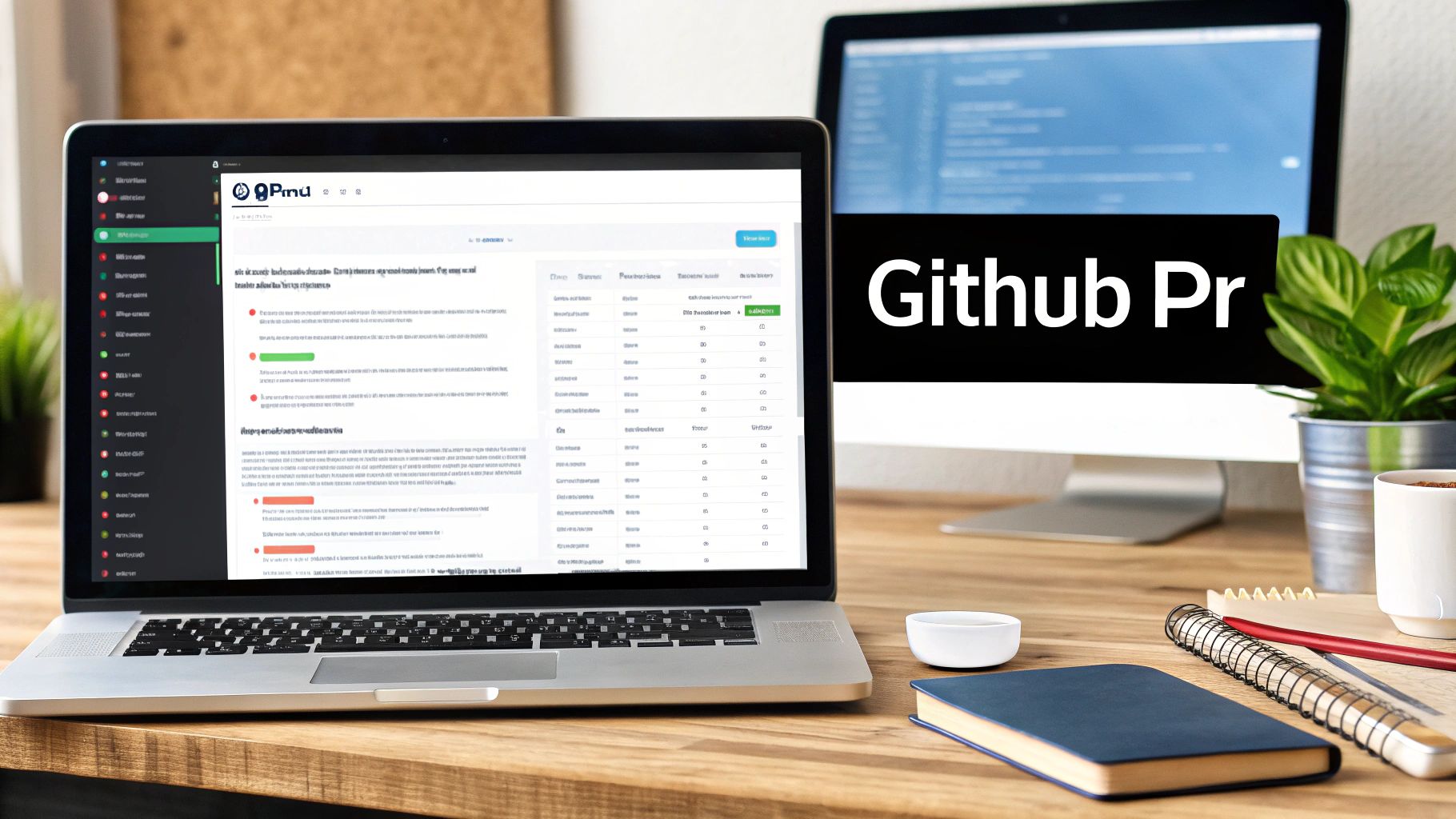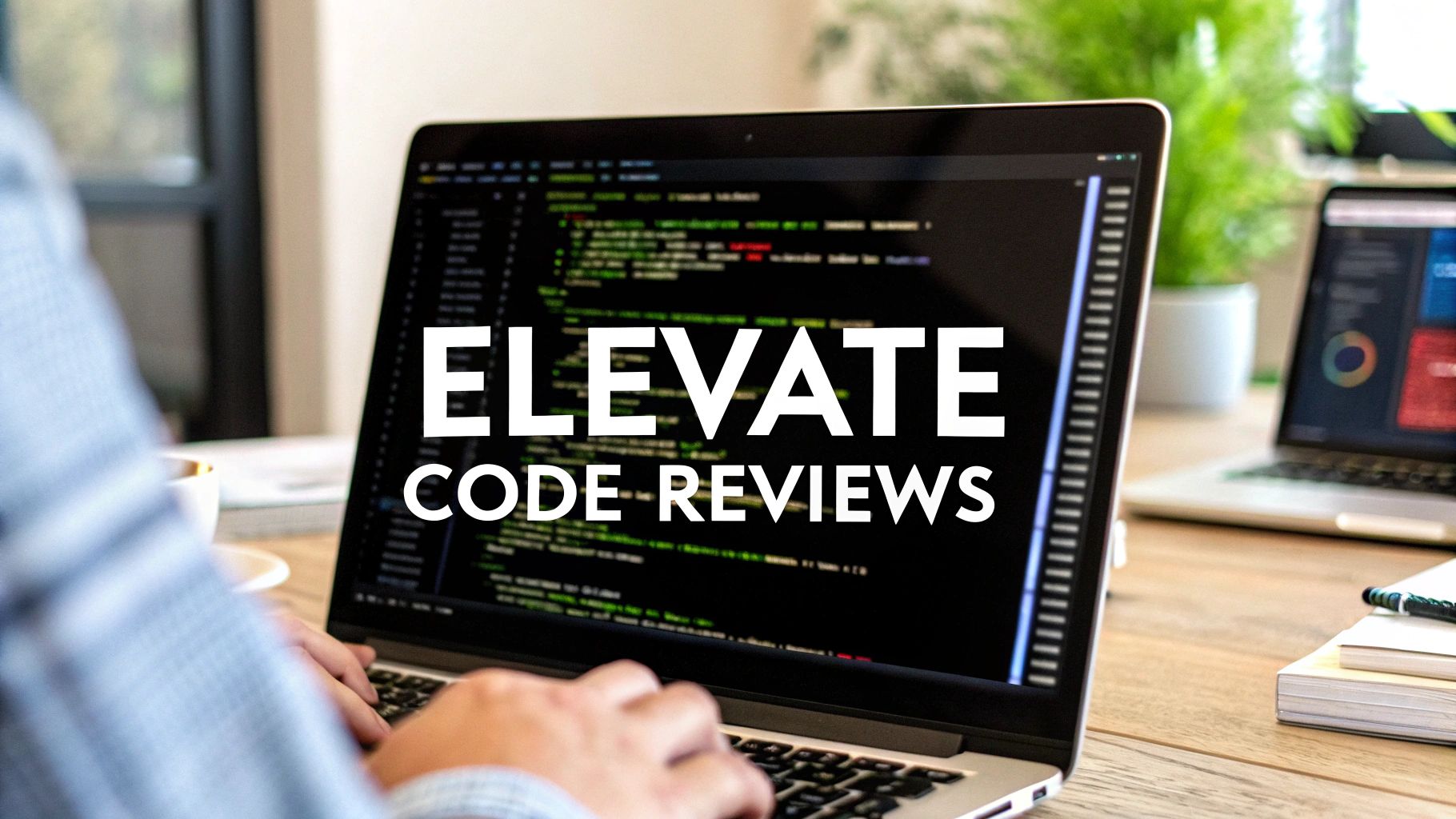github add checklist to pull request: Elevate Code Reviews
Why Pull Request Checklists Transform Code Quality

Imagine a pilot taking off without a pre-flight checklist. A scary thought, isn't it? Merging code without a proper review process is equally risky. Pull request checklists act as that essential pre-flight inspection, guaranteeing code quality and minimizing the chance of bugs slipping into production. This isn't simply about checking items off a list; it's about building a culture of quality and shared responsibility.
Checklists fundamentally alter how code reviews work. They move the focus from merely identifying errors to proactively preventing them. By offering a structured method, checklists ensure consistent attention to critical areas such as functionality, testing, and documentation. This leads to more streamlined reviews and improved code quality.
Furthermore, checklists help establish shared accountability between developers and reviewers. When everyone understands the expectations from the start, it creates a collaborative atmosphere where all parties are invested in the final result. Checklists also provide valuable direction and support for junior developers. For seasoned professionals, they serve as a valuable safeguard, catching potential oversights in intricate projects.
The advantages extend beyond individual contributions. By encouraging consistency and reducing errors, pull request checklists greatly improve team performance as a whole. Teams utilizing well-defined checklists report a 64% decrease in critical bugs and a 50% reduction in review times. These gains translate to faster development cycles, higher productivity, and a superior final product. This trend is reflected in the increasing importance of checklists within GitHub pull requests for enhancing code quality and simplifying the review process. A comprehensive checklist guides both submitters and reviewers through crucial elements of code quality, including functionality, style, testing, and security. This organized approach empowers teams to detect issues earlier, improving code quality and accelerating the development process. Learn more about integrating checklists into your GitHub workflow: Pull Request Checklist on GitHub.
Impact of Checklists on Various Development Aspects
The impact of pull request checklists spans several key areas:
- Security: Checklists can reinforce security best practices, mitigating vulnerabilities.
- Documentation: They guarantee clear and current documentation, boosting code maintainability.
- Testing: Checklists encourage thorough testing, identifying bugs before they reach users.
- Code Style: Enforcing consistent style guides via checklists enhances code readability.
These improvements not only elevate the technical aspects of the code but also cultivate a more positive and productive development experience across the team. By integrating checklist practices, teams can achieve a more efficient and effective code review process.
Crafting Powerful Markdown Checklists That Get Used

Effective checklists for GitHub pull requests are concise and action-oriented, encouraging thorough reviews. They're not about overwhelming developers with long lists of requirements. Instead, shorter, focused checklists often lead to higher completion rates and more effective code reviews. This encourages active engagement with the code, not just passive box-checking.
Formatting For Higher Completion Rates
How a checklist looks significantly impacts how developers use it. Studies show that clear formatting, such as bullet points and concise wording, can boost completion rates by a remarkable 78%. Presenting checklist items in a visually appealing and easy-to-understand way is key.
Here are some best practices to consider:
- Use clear, descriptive language for each item.
- Keep items short, focusing on a single task.
- Group related items under clear subheadings.
For instance, instead of a vague item like "Code review completed," try something more specific. "Verified error handling for all new API endpoints" is a much better example. This clarity encourages more thorough reviews and reduces ambiguity.
Language That Drives Accountability
The language used in your checklist items can significantly influence developer behavior. Phrasing items as questions, rather than statements, is a good way to increase engagement and accountability.
Consider the difference between "Are all unit tests passing?" and "Unit tests passed." The question encourages developers to actively verify the tests, while the statement might lead to a passive check without true verification.
To help illustrate how to create effective PR checklists using Markdown, the table below provides a quick syntax guide. It showcases the basic formatting and how it translates into a visual checklist within your pull request.
Markdown Checklist Syntax Guide
The table below provides a simple guide to essential Markdown formatting for creating clear and effective checklists within your pull requests.
| Syntax | Result | Example Usage |
|-------------------|-------------------|------------------------------------------------|
| - [ ] Item | ☐ Item | - [ ] Verify database migrations are correct |
| - [x] Item | ☑ Item | - [x] Implement unit tests for new functions |
| - [ ] **Bold** | ☐ Bold | - [ ] **Ensure API documentation is updated** |
These simple formatting techniques ensure checklists are clear, concise, and encourage active participation. This, ultimately, improves the quality of your codebase. Tools like Pull Checklist further enhance this by offering automated checks and reports directly within GitHub. This increases efficiency and provides greater visibility into the review process. Whether it’s a simple style check or ensuring compliance with security protocols, this structured approach promotes consistent reviews, reduces errors, and accelerates development. By integrating these strategies, you can create powerful Markdown checklists that developers will actually use, contributing to a more efficient and effective development workflow.
Building PR Templates That Engineers Actually Love

Many pull request (PR) templates are ignored or even actively avoided by developers. This defeats their purpose entirely. Instead of streamlining the review process, they become a source of frustration. This section explores how to create PR templates that engineers will genuinely appreciate and use.
One key factor is understanding the difference between a good template and a bad one. Effective templates provide guidance without being overly prescriptive. They offer a flexible framework that adapts to specific needs, rather than imposing rigid requirements. This allows for adaptability while maintaining a level of consistency. It also means the template must fit seamlessly within the team's existing workflow.
Leading organizations structure their repository-level templates to provide clear direction while minimizing unnecessary overhead. This is particularly important when integrating a checklist into a pull request using GitHub's features. Strategically placed templates, whether in the repository root or within specific folders, ensure they are easily accessible and relevant.
Template Placement Strategies
For instance, consider having separate templates for bug fixes and new features. Each has its own unique requirements and considerations. This targeted approach enhances the value and usability of your templates. This targeted approach enhances their value and usability.
Understanding developer psychology is also crucial for buy-in. Templates should empower developers, not burden them. Transparent communication about the purpose and benefits of templates can significantly increase adoption rates. Involving the development team in the creation and evolution of these templates fosters a sense of ownership. This collaborative approach ensures templates address real-world challenges and align with the team’s working style.
GitHub itself provides valuable data that can inform template design. The GitHub pull request dashboard offers insights into project activity, including metrics on community contributions and project responsiveness. This dashboard is particularly helpful for understanding project health by analyzing the open durations of pull requests. Lengthy open durations, especially in large projects, can indicate contribution difficulties. Learn more about analyzing this data.
To help illustrate the various ways you can structure your PR template directory, let's look at a comparison table. This table will outline the benefits and limitations of each approach.
PR Template Directory Structure Options
| Structure Type | File Location | Benefits | Limitations |
|---|---|---|---|
| Single Template | Root of Repository | Simple, easy to find | Not adaptable for different PR types (e.g., bug fixes vs. features) |
| Multiple Templates | Root of Repository, named specifically (e.g., PULL_REQUEST_TEMPLATE_BUG.md, PULL_REQUEST_TEMPLATE_FEATURE.md) | Clear distinction between PR types | Can become cluttered if many template types are needed |
| Foldered Templates | .github/PULL_REQUEST_TEMPLATES/ with individual files for each type | Organized, scalable for numerous template types | Requires a bit more navigation to locate |
As shown in the table, choosing the right structure depends on your project’s complexity and the variety of PR types you handle. Simpler projects may benefit from a single, easily accessible template, while larger projects might need a more organized, folder-based approach.
Finally, remember that effective templates evolve. Finding the right balance between structure and flexibility is an ongoing process, especially with growing teams or changing project phases. A team accustomed to a specific workflow may find a sudden, rigid new template disruptive.
By focusing on these core principles, you can transform PR templates from a source of friction into a valuable tool. Well-designed templates improve collaboration, reduce errors, and ultimately simplify developers’ lives. This results in a more efficient and effective development process and enhances the quality of your codebase.
Writing Checklist Items That Prevent Critical Bugs

Not all checklist items offer the same value. Simply adding a checklist to a pull request doesn't automatically improve code. The real benefit comes from carefully crafting checklist items that proactively prevent bugs and promote careful review. This involves going beyond basic "check-the-box" items and creating prompts that encourage genuine verification. When used with a tool like Pull Checklist, this method can greatly improve your team's ability to conduct high-quality reviews, minimize errors, and ensure consistency throughout your codebase.
Domain-Specific Checklist Items
Different development areas have unique requirements. A frontend checklist might concentrate on accessibility and UI testing, while an API checklist might focus on validation and error handling. Security checklists could emphasize vulnerability scanning and authorization checks. Meanwhile, infrastructure checklists might focus on resource allocation and performance testing. Adapting checklist items to a specific domain ensures the most pertinent checks are carried out.
For example, a frontend checklist item could be, "Verify keyboard navigation for all interactive elements." An API checklist item might ask, "Are all endpoints protected against SQL injection?" This level of detail makes the checklist a more effective tool for identifying potential issues.
Actionable vs. Passive Checklist Items
How you phrase a checklist item has a big impact. A passive item like "Code reviewed" offers little guidance. Instead, structure items as questions or specific actions. "Have all new functions been unit tested?" encourages active verification. "Confirm database migrations are backwards compatible" prompts a specific check.
This active phrasing results in more thorough reviews and helps uncover hidden problems. Quantifiable items such as "Test coverage above 90%" provide clear benchmarks for code quality.
Examples of Effective Checklist Items
Here's how you can create effective checklist items for different domains using Pull Checklist:
- Frontend:
- [ ] Verify cross-browser compatibility (Chrome, Firefox, Safari) - API:
- [ ] Confirm API documentation is updated to reflect changes - Infrastructure:
- [ ] Ensure resource cleanup after deployment - Security:
- [ ] Perform penetration testing on exposed endpoints
These examples demonstrate how to create checklist items for pull requests with clear, actionable instructions, leading to more effective code reviews. This focused approach, combined with Pull Checklist's automation features, enhances overall code quality and speeds up development.
Measuring Checklist Effectiveness
Tracking completion rates is a good starting point. However, true effectiveness comes from linking checklist use to a decrease in production incidents. By monitoring bug rates and other quality metrics, you can refine your checklists over time, concentrating on the items with the greatest impact. Pull Checklist's reporting tools simplify this tracking, providing valuable data on checklist adherence and its relationship to code quality.
This data-driven approach helps ensure your checklists stay relevant and beneficial to your team. As your codebase and team change, so should your checklist, continuously adapting to new challenges and best practices. Regularly evaluating and updating your checklists creates a dynamic quality assurance system that actively contributes to the success of your projects.
Supercharging Checklists With Strategic Automation
Manual checklists are a great starting point for boosting code quality. However, top-performing teams are going further by strategically integrating automation. This creates a more robust quality assurance process, combining the strengths of human judgment with the efficiency of automated checks. Let's explore how to effectively integrate GitHub Actions with your Pull Checklist to automate verification wherever possible.
Identifying Automation Opportunities
Not every checklist item is a good fit for automation. Items requiring subjective evaluation, such as code design or user experience, still benefit from a human touch. However, many tasks, particularly those involving repetitive checks or clearly defined criteria, are perfect candidates.
Consider these examples:
-
Automated: Checking for code style compliance, verifying test coverage thresholds, ensuring proper documentation formatting.
-
Manual: Evaluating the clarity of variable names, assessing the overall architecture of a new feature, confirming the user-friendliness of a UI change.
By automating these routine checks, developers can dedicate their review time to the more complex and subtle aspects of the codebase.
Implementing Automated Checks With GitHub Actions
GitHub Actions seamlessly integrates with Pull Checklist, automatically enforcing checklist completion. This involves defining workflows triggered by pull request events. These workflows can execute scripts or leverage pre-existing GitHub Actions to verify specific checklist items.
For instance, a workflow could automatically run linting tools to enforce coding style guidelines. It could also execute tests to verify code functionality and coverage targets, and even check for updated documentation. These automated checks can then be linked to specific Pull Checklist items. Once the workflow completes successfully, the corresponding item is automatically marked as checked, saving developers valuable time and ensuring consistent adherence to established standards.
Setting Up Status Checks and Branch Protection
GitHub Actions' status checks provide immediate visual feedback within the pull request interface. This gives everyone instant visibility into the status of automated verifications. Moreover, branch protection rules can be configured to enforce these checks before a pull request is eligible for merging.
As an example, a branch protection rule might require all automated tests to pass and code style checks to succeed before merging. This safeguard prevents code that doesn't meet these criteria from being integrated into the main branch, maintaining a consistent level of quality and preventing accidental merges of non-compliant code.
Building a Progressive Automation Strategy
Begin by automating a few key checklist items and gradually expand as your team becomes more comfortable. This fosters smooth adoption and prevents overwhelming your team with too much automation at once. Consider a phased approach:
-
Basic Automation: Start by automating simple checks, such as code style and basic tests.
-
Intermediate Automation: Incorporate more complex checks, such as security scans or integration tests.
-
Advanced Automation: Implement custom workflows that automatically generate documentation or deploy code to staging environments.
This progressive implementation lets teams adapt to automation at their own pace and fully realize the combined benefits of human expertise and automated efficiency. Pull Checklist supports this gradual approach. You can choose which items trigger automated workflows, tailoring those workflows to your specific project needs. This flexibility simplifies automation adoption without disrupting existing workflows, empowering you to create a system tailored to your team's specific requirements and priorities.
Advanced Checklist Techniques From Elite Teams
Building effective pull request checklists and embedding them within templates is crucial for ensuring code quality. But truly elite teams go beyond these basics. They create dynamic, adaptive systems that constantly evolve alongside their codebase, focusing on context, specialization, and continuous improvement.
Context-Aware Checklists
Imagine a checklist that intelligently adjusts based on the specific changes within a pull request. This is the power of context-aware checklists. Instead of a static list, the checklist dynamically adapts. For example, if a pull request modifies the database schema, the checklist automatically adds items related to data migration and backup verification.
If the changes involve security-sensitive code, items on penetration testing and vulnerability scanning will appear. This dynamic approach ensures the most relevant checks are always applied, even as your codebase grows and evolves.
Specialized Checklists For Different Reviewer Roles
Large projects often involve multiple reviewers with different expertise. A frontend specialist focuses on UI/UX elements, while a backend engineer concentrates on API integrity and database interactions.
Tailoring checklist sections to specific roles streamlines the review process. Each reviewer sees only the most relevant items, reducing cognitive load and improving review efficiency. This targeted approach ensures every aspect of the pull request receives appropriate scrutiny from the most qualified individuals.
Evolving Your Checklist System
Top-performing teams treat their checklists as living documents, constantly refining them based on performance data. This goes beyond simply tracking completion rates. It involves correlating checklist usage with key quality metrics like bug rates and production incidents.
If a specific checklist item consistently prevents critical bugs, its importance is reinforced. Less effective items are revised or removed. This iterative process ensures the checklist remains valuable and aligned with the team's evolving needs and priorities.
Measuring Checklist Effectiveness Beyond Completion
While checklist completion is a useful metric, it doesn't tell the whole story. Elite teams delve deeper, analyzing how checklists impact broader quality outcomes. They track the correlation between checklist adherence and the number of bugs found during testing, after deployment, or reported by users.
This helps identify which checklist items are most effective at preventing problems and which ones might need refinement. By focusing on the impact of the checklist, teams can continuously improve their effectiveness.
Frameworks For Progressive Implementation
Implementing these advanced techniques doesn't require a complete overhaul of your existing workflow. A phased approach, often called progressive checklist implementation, is key. Start with a basic checklist and gradually add complexity as your team gains experience.
As your team matures and your project grows, incorporate context-aware checks, specialized sections for different reviewers, and data-driven optimization. This allows your checklist system to evolve alongside your development practices. Teams using this approach have seen improvements, from faster review cycles to a significant reduction in production bugs. They build systems that adapt and grow, constantly seeking improvement.
Ready to streamline your code review process and improve code quality? Pull Checklist, a GitHub Marketplace app, empowers your team with powerful, condition-based checklists directly within your pull requests. Automate tasks, enforce blocking checks, and gain valuable insights with reporting functionality. Visit Pull Checklist to transform your workflow today!
